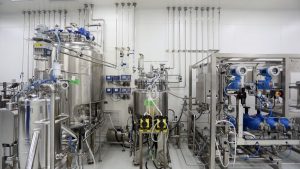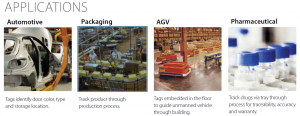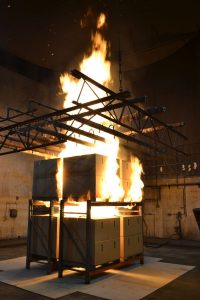Advanced insulin production facility, with integrated process control system, creates completely automated facility, which raises the benchmark for process operations
Background
Established 40 years ago, Biopharmax designs and builds manufacturing facilities around the world, specialising in the pharmaceutical industry. Actively present in Europe, China, India and the Middle East, it undertakes turnkey projects, from user requirement specifications and conceptual design through implementation to successful validation, and has designed and constructed over 100 facilities in 14 countries around the globe.
Biopharmax was challenged to design a new Life Science and Technology park in China, spanning a total area of 120,000 square meters. The first facility built in the park was a 7,000 square meter insulin production facility, which had to meet all relevant regulatory requirements established by the U.S., Europe, and China. The company not only had the expertise and experience in the engineering arena, but was also familiar with a variety of technologies in the pharmaceutical field. In this instance, they used an insulin technology, based on recombinant e-coli fermentation that was procured from a third party.
Challenge
Insulin production involves a very complicated automated production process, which includes process systems and equipment, clean utilities, industrial utilities, clean rooms, laboratories, warehousing and control systems to run production, in addition to all the associated commissioning and validation. In this instance, production complexity and recipe variety compounded the challenge, requiring the development of tailor-made process applications capable of supporting more than 300 phases and 70 recipes.
Biopharmax also faced a very short commissioning time, and numerous sub-contractors and suppliers from a wide range of disciplines and countries, which required a special approach to bridge the cultural and language barriers.

Solution
The application, based on the Rockwell Automation process control system, comprises over 10,000 I/O and a range of process controllers – from large to micro-sized. System flexibility allows the implementation of a PlantPAx® system for the fermentation process and a tailor-made implementation for the other process areas, providing a complete integration of both application techniques using the same engineering and operation tools. Controllers collect and process the field information from distributed I/O and redundant I/O in critical areas.
Field information and process data is accessible from a central control room. Allen-Bradley® PowerFlex® variable frequency drives are also deployed at key points within the facility to provide more efficient and monitored motor control.
From a visualisation perspective, Biopharmax has leveraged high-end operator workstations (OWS), which provide an operator interface with advanced diagnostics and access to all relevant process components such as pumps, valves, etc. Biopharmax used its own special pharmaceutical library based on Rockwell Automation process objects and its associated faceplates for ease in design and engineering. A virtual system was deployed to deliver redundancy and increased system availability. Two physical servers – one for production and a second to provide redundancy – utilising VMware virtualisation technology, enable quick disaster recovery.
The plant process batch and recipe formulation is fully automatic, is implemented according to the S88 standards and incorporates modular software blocks and fixed FDS Syntax, offering quick and efficient troubleshooting. Batch reports were also implemented, which describe the batch process activity, including critical parameters, alarms and events, batch listing, batch summary, batch execution, material usage, forward tracking, and backward tracing.
The process control system also offers validation management, so whenever a new operator station is added, validation is done only for that specific stand. Historical data is also stored to a SQL database, which includes all system alarms and events and field device data (trends).
Finally, the EtherNet/IP communication link between the controllers on the diverse process areas and the different system components like: variable-speed drives, remote I/O and weighing scales, coupled to the serial link communication with the fan filter units (FFU), allows the system to analyse the highly detailed data received and execute the control and corrective measures where required. This significantly increases the system reliability and performance in response to changing conditions, as well as helping to optimise energy consumption.
Results
According to Sarel Chen Tov, CEO of Biopharmax: “Biopharmax is committed to putting the customer’s needs and long-term goals at the centre of its concerns. This project demonstrated how we delivered an end-to-end solution, implementing third-party process technology in a turnkey project. As the customer had a strong business orientation, with limited operational experience with insulin production, Biopharmax took the responsibility of selecting the proper equipment and implementing the most suitable recombinant E.coli cell line.”
The deployment of the Rockwell Automation process control system reduced development and installation time, as all systems have similar protocols and all communication was based on EtherNet/IP. Indeed, as Lior Meir, Lead-Control Systems, at Biopharmax explains: “We saw a start-up time of just six months from end of mechanical completion to execution; this is very short in comparison to other similar processes, which usually take around 18 months to complete.”
According to engineers on the project, the system is very easy to program and configure and the integration between software, controllers and the I/O helped improve reliability and was user-friendly. The engineers also appreciated the speed at which the system could be installed as a result of the EtherNet/IP architecture with its immediate ‘plug and play’ capability. Other benefits of the fully integrated system include: common programming standards, easier trouble shooting and correction, efficient validation without any redundant work.
Biopharmax created a facility which is completely automated; with the control of the entire facility taking place in one control room. For the customer this means that the system controls all aspects of the process, providing complete visualisation and operator interface; there is no need to go between rooms for inspection – all inspections can be done from one spot. The use of automatic recipes in this facility has also resulted in minimum human intervention in the production process, reducing the possibility of human error and contamination risks. This, in turn, has led to increased efficiency and higher yield.
This article was written as part of a precess industry marketing campaign for Rockwell Automation
The resulting PDF, also prepared by me, can be found here: EMEA1967 Biopharmax (Lo)



